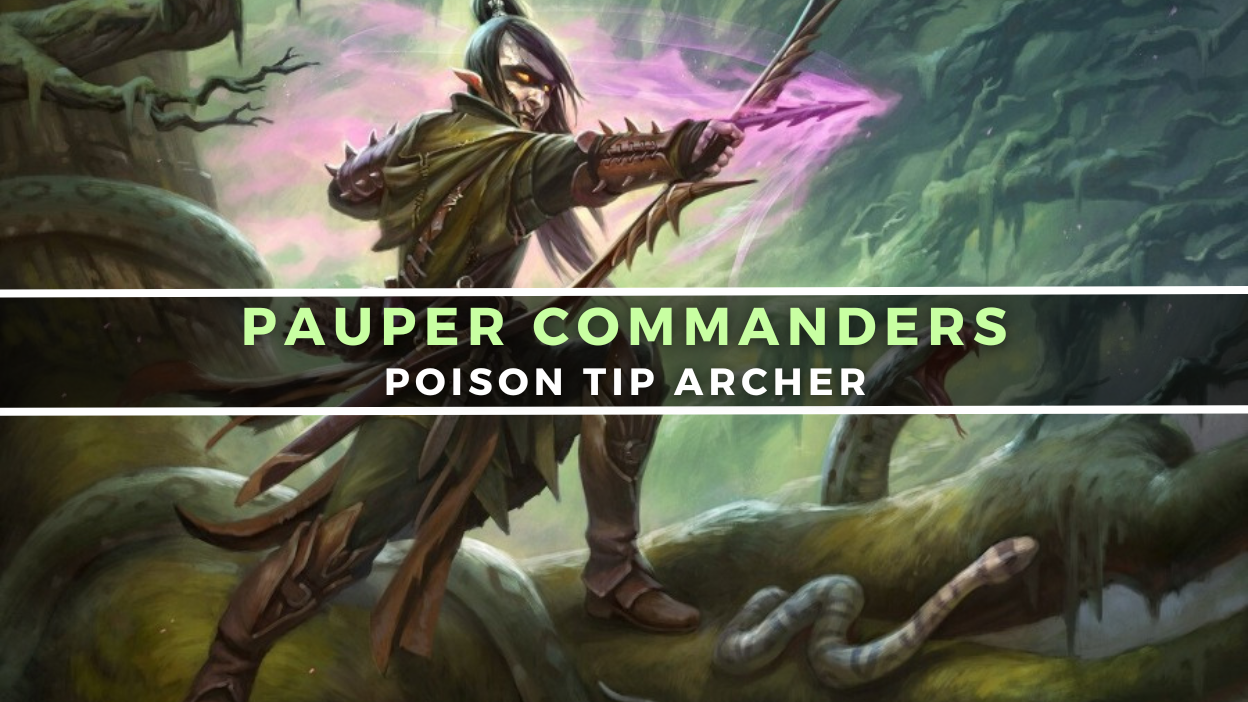Pauper Commander - Poison-Tip Archer

Keep it Simple
It's occurred to me that one of the best things about Pauper, and, by extension, Pauper EDH, is the simplicity of the card pool. There's nothing big or flashy, just a bunch of commons that, while mundane, are the backbone of all of Magic. Even the most flamboyant of formats, Legacy and Modern, play commons like Crop Rotation
There's nothing complex about these cards, and that's why some of them are so strong, so rather than build a deck with combos or strange twists, let's dial it back and play a deck inspired by the simplicity of commons. A simple deck that just wants to do one thing and do that one thing really well.
The commander I've selected is Poison-Tip Archer
I guess if I'm gonna be dramatic about the source of inspiration for this deck, I might as well make up some more themes. Let's talk about life and death. In order for the every living thing to meet its demise, it must first be born. For the end of life to come about, there must be life in the first place. If we're gonna be sacrificing a ton of creatures, we need a ton of creatures to start with.
Therefore, inspired by the progression from birth to death, we're going to run a bunch of creatures that create their own spawn to populate the earth, sometimes literally. Dread Drone
Handily, many of the tokens we're making can sacrifice themselves, reducing the need for sac outlets.
Some creatures leave life behind when they exit the mortal plane (The Battlefield.) Brindle Shoat
We all create new life as we live ours, whether it's through inspiration, protection, or uh, more physical means. All these creatures represent the life we pass on as we depart. But what's actually important is that we can sacrifice them twice and trigger our commander an additional time.
A lot of these cards will make even more than two bodies, like Fin-Clade Fugitives
Cards in the deck are ranked by how many times they can make our commander trigger on their own, and the top dog is definitely Exquisite Huntmaster. It's got an encore ability, just like Fin-Clade Fugitives, but it creates another body when it dies. Six creatures. Excellent!
The final part of our extended circle of life metaphor is rebirth. We die, and our bodies decompose, absorbed into the ground that grass, flowers and trees will soon sprout from. The useless, decaying flesh will feed new life. In Magic, rebirth is a lot more literal. We're just gonna return creatures from our graveyard to our hand, then recast them.
Death Denied
Revive the Shire
Sacrificing and recurring the right creatures over and over again can create a ton of value and potentially expand our board state, meaning that the Poison-Tip Archer
Now that we've got the life part of the deck, let's figure out the death part. Death comes about in all sorts of ways for us, from natural causes, to disease, to pure misfortune. But in this deck, we've got something specific in mind: ritual sacrifice.
We're running all the usual sacrifice cards, from Viscera Seer
To remedy that, we're also running a ton of free sacrifice outlets, like Ashnod's Altar
It's also important to keep in mind that our opponents' creatures can also trigger our commander.
Killing stuff on the other side of the board isn't our main focus, given that it's difficult to wipe out opposing creatures en masse, let alone ensuring that our opponents have a hoard in the first place, but there are a few cards that can do the trick. Fleshbag Marauder
The difference between them and Diabolic Edict
But even as life cycles, we eventually get to the point when all things must go. The apocalypse, I suppose. In pauper, there's not much in the way of board wipes, but there are two cards that can emulate a plague. Crypt Rats
Pauper Commander - Poison Tip Archer
View on ArchidektCommander (1)
Instants (8)
Creatures (46)
- 1 Abyssal Gatekeeper
- 1 Accursed Marauder
- 1 Arbor Elf
- 1 Blisterpod
- 1 Blood Seeker
- 1 Bloodflow Connoisseur
- 1 Bloodthrone Vampire
- 1 Briarblade Adept
- 1 Brindle Shoat
- 1 Carrion Feeder
- 1 Caustic Caterpillar
- 1 Crypt Rats
- 1 Demon's Disciple
- 1 Dread Drone
- 1 Drey Keeper
- 1 Elves of Deep Shadow
- 1 Elvish Mystic
- 1 Essence Warden
- 1 Evolution Witness
- 1 Exquisite Huntmaster
- 1 Eyeblight Cullers
- 1 Eyeless Watcher
- 1 Falkenrath Noble
- 1 Farhaven Elf
- 1 Fin-Clade Fugitives
- 1 Fleshbag Marauder
- 1 Fyndhorn Elves
- 1 Kozilek's Predator
- 1 Llanowar Elves
- 1 Mortician Beetle
- 1 Nadier's Nightblade
- 1 Nantuko Husk
- 1 Nest Invader
- 1 Nested Shambler
- 1 Rift Sower
- 1 Rot-Tide Gargantua
- 1 Sakura-Tribe Elder
- 1 Satyr Wayfinder
- 1 Slum Reaper
- 1 Spore Frog
- 1 Springbloom Druid
- 1 Tukatongue Thallid
- 1 Vermin Gorger
- 1 Viscera Seer
- 1 Warteye Witch
- 1 Yavimaya Elder
Sorceries (12)
Enchantments (2)
Artifacts (4)
And that's the deck. Like I said, it's extremely simple, just like our lives. Things live, and things die. Some might say that they're born just for the purpose of dying, but I think that our cards create a lot of meaning even in the minuscule amount of time they're on the board.
No matter how small and insignificant that 1/1 Squirrel may seem, it could always be the difference between victory and defeat. Consider that the next time you're thinking deep thoughts.
No Magic: The Gathering token has ever questioned its purpose in life, even if it's just there to make two mana with Ashnod's Altar